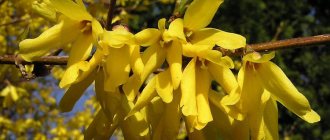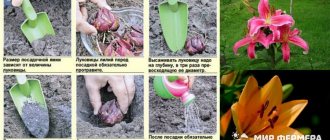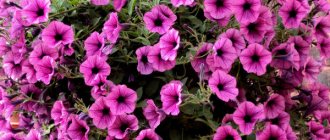The ancient Greeks called this flower “daughter of the wind” (anemone) for its unusually thin and delicate petals, fluttering at the slightest breeze. It received a similar name in Russian - anemone. There are many legends about it, the essence of which boils down to the fact that beautiful anemones are a symbol of sadness and the transience of life. In fact, they look very bright and cheerful, have a huge variety of shapes and colors, for which they are universally loved by gardeners and landscape designers and because of which they often cause difficulties in planting and care. How to plant and grow anemones correctly depends on their variety.
General information
Anemone belongs to the Ranunculaceae family and is a herbaceous perennial with a powerful long rhizome or tuber. The genus includes more than 150 species, blooming at different times and in completely different ways, which confuses even experienced gardeners. They can be 10 cm in height, or reach 1.5 m. The peduncle may be thrown out of the basal rosette, and in other species it may be completely absent.
Distributed in both hemispheres on plains and mountains, with the exception of the tropical zone. Nine species of anemone have become established even in the Arctic Circle, but the most decorative varieties came to us from the Mediterranean countries.
Planting and care according to the category of complexity directly depend on the type of their root system. Rhizomatous varieties are quite easy to grow, but mistakes in caring for tuberous varieties can be expensive.
Ephemeroids and plant replanting
Each variety must have its own unique cultivation technology. It is worth highlighting plants in a special group, which are called ephemeroids. Their main feature is their rather short flowering cycle. The dormant state of a garden crop may be broken in April, but the first flowers will open only at the end of May. By July the plants will go back to sleep. However, if favorable conditions are created for them, the foliage can persist until autumn. After the last flowers have faded, it is necessary to replant the spring anemones, otherwise they will grow quite quickly next year.
Transplantation of anemones that have rhizomes should be carried out in October or with the arrival of spring, as soon as the last snow has melted. First of all, you should soak the root system of the plant in warm water for several hours. This procedure is carried out so that the flower can better withstand the stress of transplantation. After this, we plant the plants in new places, deepening them into the ground no more than 10 centimeters.
Classification according to flowering time and shape of the root system
It is, of course, impossible to describe and even list all one and a half hundred species of anemone. But it is convenient to divide them into groups according to their main distinguishing features. We will talk about cultivated anemones and those of their natural varieties that are involved in the creation of numerous hybrids.
Early flowering rhizomatous
Before everyone else, immediately after the snow melts, the buds of the ephemeral anemone open. They have a very short life cycle - immediately after the color fades, the plant itself dries out.
Dubravnaya
The flowers are usually white, but can be pink, beige, lilac or have a greenish tint. They grow in the wild, but also have several garden forms. In height - no more than 10 cm.
Lutichnaya
A taller species, reaching 25cm. The petals are yellow in color; double varieties are grown in cultivation.
Altai
The bud has from 8 to 12 petals, white inside and with a slightly bluish tint outside. Reaches 15 cm. A fairly ordinary variety.
Tuberous mid-early anemones
These species also bloom in the spring, but later, and also have a short growing season. These are the most beautiful varieties among anemones.
crown
The most popular and spectacular, also the most capricious in relation to growing conditions. Planting and caring for it is also far from the easiest. The flowers are similar in shape to poppies, but can be of different colors, both bright and muted tones, including two-tone ones. Up to 45 cm in height. There are simple and terry varieties of garden forms. This species is used as a forcing plant indoors.
Tender (Blanda)
Cold-resistant and tolerant of lack of moisture. It grows up to 15cm, has a large number of cultural forms of various colors.
Sadovaya
Large-flowered species, up to 5-6 cm in diameter, 15-30 cm high. It stands out among other varieties with its openwork foliage and has a large color palette. The tubers of this anemone should be dug up for the winter.
Caucasian
The flowers are light blue, plant height up to 20cm. Cold-resistant, light-loving species that prefers moderate moisture. Apennine
Produces single dark blue buds no more than 3 cm in diameter. One of the most cold-resistant varieties of the tuberous variety, which can overwinter in the ground.
Crown anemone, like other varieties whose tubers must be dug up in winter, begin to bloom in the garden later than their close relatives in natural conditions.
Autumn anemones
Anemones, which bloom buds in August-September, are classified as a separate group. All its representatives are rhizomatous and tall. Flowers of autumn varieties form looser clusters of inflorescences and have “splayed” shoots. Once the plant has taken root, caring for it will no longer be difficult.
Japanese
The average height is 80cm, but some varieties of this variety reach 130cm. Some roughness of the pinnately dissected foliage is compensated by elegant pastel inflorescences, which can be either simple or double in shape.
Hybrid
Stems are medium or tall, up to 120cm. It produces numerous root layers, thanks to which it grows very quickly. The flowers are semi-double, up to 6 cm, in shades of pink to deep crimson, with a bright yellow core. Blooms at the end of summer and continues flowering for a month, prefers partial shade. It is not a winter-hardy species and requires shelter for the winter. Looks great in compositions with ornamental cereals, hydrangea, rhododendron and other spherical plants.
Popular types and varieties
The varietal diversity makes anemones an extremely popular ornamental plant among gardeners. If you wish, by planting flowers with different flowering periods, you can admire the colorful flower beds all season long.
Anemone tender
Tender anemone are compact bushes 10 cm high with white, blue or pink flowers. The flowers are 2–4 cm in diameter. It blooms in May, and in June the growing season ends and its leaves dry out. Flowering time - no more than 3 weeks. Tender anemone is resistant to low temperatures, is not afraid of pests and is easy to care for. Prefers to grow in slightly shaded places.
The tender anemone variety “Blue Shades” is quite frost-resistant, practically not affected by any diseases and is very unpretentious
Crown anemone
Crown anemone is heat-loving and quite capricious. The flower, originally from the Mediterranean, grows up to 30 cm. The color of large (up to 8 cm) flowers is red, pink, lilac and white. Hybrid varieties can be terry with a border or interspersed. The species is not frost-resistant, but the crown anemone blooms in spring and autumn, although autumn flowering is less expressive. Requires good light and alkaline soil. Crown anemone is the most popular species for cultural plantings. It has many varieties.
Photo gallery: popular varieties of crown anemone
Anemone "Bicolor" is used to decorate flower beds
Anemone "De Caen" opens its buds with the arrival of summer; in hot weather it fades, but blooms again in the fall
Externally, “Mount Everest resembles two flowers at once - an aster and a dahlia; its double snow-white petals form large flowers with a diameter of up to 10 cm
This variety of double anemone reaches a height of 30 cm, it has few leaves, but the single flower is very large - up to 10 cm in diameter
The Fokker variety is used in floristry and landscape design.
Japanese anemone
Japanese anemone is an autumn species. Flowering begins in early autumn and continues until frost. Grows in large bushes up to 1.5 meters high. Flowers of some varieties can be semi-double or double. The shades are very diverse - from delicate light to dark saturated. The Japanese anemone does not tolerate frost well; it needs to be covered for the winter. Loves sunny places.
Japanese anemone does not immediately attract attention, but it is difficult to take your eyes off its graceful flowers
Forest anemone
Wood anemone is the most common species in Russia. Her home is a shady forest, forest edges and even rocky slopes. It grows equally well in fertile and poor soils. Forest anemone blooms early and blooms for only about a month. The stem grows only up to 20 cm, the delicate white flowers with a yellow center are small - up to 3 cm.
Forest anemone is easy to care for and is suitable for growing in the middle zone
Hybrid anemone
Hybrid anemones are an autumn species, bloom in August - September and bloom for up to 40 days. Strong stems do not need support, although their height can reach 1 m. Large (5–8 cm) flowers are collected in umbrella inflorescences; there are double varieties. Shades - delicate pink, white, carmine, red. Abundant flowering is ensured by fertile, loose soil.
"Queen Charlotte" grows up to 60–90 cm, the flowers are of medium size, the flowering period is from mid-summer to the first frost
Planting in spring in open ground
You can plant anemones in the spring either by seeds in open ground or by seedlings. Direct planting in open ground in the fall is also practiced. According to the well-established opinion of gardeners, only seed collected in the current season is suitable for autumn sowing. Seedlings are planted in early spring. In both cases, an important rule must be observed: the seeds should not be buried too much due to the fragility of the sprouts, which may not reach the surface. It is enough to simply sprinkle them with earth, preferably through a sieve. At home, you can even leave them on the surface, lightly pressing them against the surface of the soil and moistening them.
Autumn crops will sprout immediately after the snow melts, but here they will face a serious test from the soil oversaturated with moisture. Overwatering can destroy the seedlings completely. Therefore, you should not choose low-lying places for this method of reproduction.
Anemone planted with seeds will produce buds only in the third year!
Features of cultivation
The main feature in growing Anemone is the nature of the root system of the flower. All varieties can be divided into:
- Tuberous.
- Rhizomatous.
The latter are the most unpretentious both in terms of weather conditions around them and in terms of maintenance. Anemones with rhizomes easily grow in poor soils and withstand wind, heat and inconsistent watering.
Tuberous ones are the opposite. They definitely need to be taken care of carefully:
- For example, plant them with seeds and only before winter.
- Planted flower beds must be covered for the winter. Fallen leaves or tops from the harvested crop are suitable for this.
- With the onset of heat, water the flowers, loosen the soil and remove weeds.
- In the fall, fertilize the bushes with standard mineral fertilizers.
But tuberous varieties, with proper care, grow much stronger and stronger than rhizomatous varieties. Anemones with tuberous roots have noticeably larger flowers. With bright, massive petals, they rise quite high (the highest varieties reach 1.5 m), which, undoubtedly, only ennobles any flower bed where they grow.
Features of planting a flower in open ground
Anemone can be planted in open ground in the three most common ways :
- tubers;
- seedlings;
- seeds.
One of the simplest options is to plant the tubers immediately in a permanent place. It will be a little more difficult with transplanting using the seedling method. The most difficult way is to germinate seeds directly in the open ground, since this requires a suitable climate, an optimal ratio of humidity and soil characteristics.
Planting with tubers
Planting Anemone with tubers is a simple matter. The only important point is that you need to determine the growth point. That is, the tuber should be located in the hole with this point up.
Anemone tubers
Seeing the growth point is also relatively easy. To do this, the tubers should first be soaked in warm water. The swollen tubercles on the tuber will be the same growth points.
Another tip: experienced gardeners who are interested in propagating Anemones notice that the growth points on the tuber are located mainly on the flat side. This means that you need to plant the tuber with the sharp end down.
How to choose planting material?
Giving preference to planting Anemone with tubers, it is important to be able to choose high-quality planting material in the spring.
- Firstly, you should pay attention to the external condition of the tubers. It is better to get rid of rotten and too small tubers immediately.
- If the root is large, but there is a rotting or simply damaged part on it, then the affected area can be carefully cut off. The rest of the tuber is suitable for planting.
- You definitely shouldn’t put several tubers, even small ones, into a hole at once. In fact, this will definitely not lead to anything good. In the worst case, nothing will grow in this place. In the best case, very soon you will need to plant bushes that have grown too densely.
Before planting on the site, it is advisable to soak the tubers in a weak solution of potassium permanganate. This will help get rid of harmful bacteria.
Holes about 15 centimeters deep are prepared for the tubers. Next to the planted Anemone, you can sprinkle a little humus and sawdust to feed and retain moisture, and then cover the bed with soil.
How to soak tubers before planting?
There is no consensus on the need to soak Anemone tubers. Some people do without this procedure.
Supporters of a different opinion are sure that it is absolutely impossible to do without treating the tubers with a weak solution of potassium permanganate after winter. Thanks to this treatment, it is possible to prevent rotting, diseases and the proliferation of pests in the soil.
Anemone tubers can be removed from winter storage areas already in mid-April, about a week, maximum two, before planting in the ground. At first, the tubers can be stored in a warm and dry room. You can plant them even with sprouts that have appeared. This will make it even easier to determine growth points.
It is not necessary to keep the roots in the potassium permanganate solution for a long time; you can limit yourself to just a half-hour or hour-long procedure. After this, they immediately begin planting.
Soaking anemone tubers
How to sow seeds outdoors?
Anemones are relatively easy to grow from seeds, but if you plant the plants immediately in a permanent place, the first shoots will hatch rather slowly: after about a year.
It is much easier to germinate seeds at home first. This is how it is possible to maintain optimal levels of humidity, light and temperature, constantly monitoring all indicators.
In the second year, the sprouts can be planted in open areas. You should only take care of good protection from wind and too bright sun. Then monitor the correct frequency of watering, and cover the bushes with foliage for the winter.
If everything is done correctly, then the first flowering of Anemone can be achieved no earlier than three years after planting the seed.
What kind of soil do plants need?
Despite the fact that most Anemone varieties are famous for their unpretentiousness to external conditions, it is still advisable to prepare the soil before planting.
First of all, Anemones love loose soil. If the ground on the site is hard, then you can add sand to it. Sand, by the way, will at the same time increase the drainage of the upper layers of the earth, which will contribute to the correct and rapid growth of the rhizome.
In areas where acidic soils predominate, wood ash or dolomite flour added in a thin layer on the surface will help correct the situation.
It is believed that the most suitable soil for growing Anemone is loam with peat . It will contain enough minerals for growth, it allows the optimal amount of moisture to pass through, and it is also relatively light and loose for the germination of fragile and, frankly, weak roots (we are talking about root anemones). Ordinary deciduous soil with humus is also suitable.
How to choose a landing site?
Anemones in a flowerbed
When choosing a place for a flowerbed with Anemone, you need to pay attention to the following characteristics:
- For very young sprouts, a place protected from drafts is best suited. The young roots of the plant are so weak that in an open area they simply cannot withstand strong gusts of wind.
- Also, for young plants you should choose partial shade or even completely shady areas. Intense heat, and especially direct sunlight, greatly dries out the soil around Anemone bushes and makes it impossible for them to grow quickly.
- At the same time, it is worth making sure that Anemone has enough space to grow. Between the bushes you need to maintain a step of 30-40 cm. The same rule applies to the distance between the beds.
For all the above reasons, the best places for Anemone bushes include the courtyard of private houses, areas next to garden trees, flower beds along fences and walls.
Flower beds with anemones
Preparing seeds before sowing
The seeds of this crop have poor germination (no more than a quarter of the material), so before planting anemones, germination with preliminary stratification is necessary. This concept means simulating wintering conditions without critical temperature drops.
The seeds are placed in a damp sand-peat mixture (1:3) and kept warm for several days until they swell. After this, the soil substrate is moistened again, its volume is slightly increased and the container is moved to a cooler place for a few more days. During this time, the seeds should hatch. And finally, the container with the seeds is sent “for wintering” to a cold place. It is best to bury the container in the ground and cover the top with insulating materials and then with snow.
In the spring, you need to dig up the container as soon as the ground thaws, and plant the anemone seeds for seedlings.
You should know! When propagated by self-collected seeds, the color of the resulting plants is paler than that of the mother plant.
Diseases and pests
Depending on the variety, anemone can be capricious or unpretentious. Gardeners sometimes have difficulties growing flowers. Let's look at the most common problems that may arise:
- Viral diseases can manifest as spotting of foliage, it turns brown and growth slows down. In this case, diseased plants must be destroyed so as not to infect others.
- If a black coating appears on the bottom of the leaves and white on top, this indicates downy mildew . This often occurs when there is poor heat exchange, for example, when growing plants in a greenhouse. It is recommended to establish a ventilation, watering and lighting system.
- When attacked by aphids , the leaves turn yellow and curl. When touched, you may notice a sticky coating. Chemicals can save the anemone - Antitlin, Tobacco dust, Actellik.
- Molding nematodes are small worms that attack leaves and trunks. To get rid of them, you need to irrigate the plants with Fufanon or onion infusion (2 kg of chopped onion per bucket of water, leave for 2 days, strain and spray).
Brigid Mixed
How to grow anemones from tubers by division
It is best to carry out the procedure in the spring. To do this, tubers dug up in the fall are taken or those that have overwintered are dug up. Using a sharp knife, they are cut into pieces so that each one contains the lower, horse part, and at least one kidney. The cut is sprinkled with wood ash. The resulting planting material is placed in the hole in a horizontal position and sprinkled with a layer of soil no more than 5 cm. The soil is moistened and slightly compacted. Young seedlings obtained in this way will become full-fledged adult plants only in the third year.
Reproduction
The plant reproduces in several ways:
- Tubers (description above).
- Seeds (description above).
- By dividing a bush or rhizome . In early spring, when there is no longer frost, the root is dug up and modules 5 cm long are separated from it. It is important that each element has a bud. Then they are placed in loose and pre-fertilized soil.
Division by rhizome is carried out only from mature plants that are more than 4 years old.
It is best to propagate anemones in the spring by root suckers or seeds sown closer to winter.
Anemone seedlings
Transplanting tuberous varieties
Planting tuberous varieties, which are dug up in winter, is somewhat more difficult than rhizomatous varieties. This process requires preparation. To do this, the tubers must be soaked, but not completely immersed in water, because this will lead to their rotting, because they absorb water like a sponge. To do this, it is recommended to use a cloth soaked in water and well wrung out, in which the seed is wrapped and then placed in a plastic bag. To speed up the process, you can add any biological stimulant to the water. They should stay in the bag for 5-6 hours, no more.
During this time, a small amount of soil mixture is prepared - sand or a mixture of sand and soil, which must be light and permeable. Spread it in an even, shallow layer in a wide container, level it and moisten it moderately, then remove and spread the prepared tubers directly on the surface.
The entire container is placed in a bag and taken out to a cool place. You can cover the container with glass. It is necessary to ensure that the soil is constantly moist, but not wet.
Anemone tubers are planted with the sharp end down, while the flat side should be on top. If it is difficult to determine the top and bottom of unsprouted tubers, they should be placed sideways.
Flowering conditions
In general, Anemone begins to bloom quite early even without thorough care. Some varieties even bloom twice a year.
What you will need to especially watch out for is:
- So that the bushes are planted in partial shade. Too much sun can harm the plant. As well as the complete absence of sunlight - too.
- Do not overdry the soil near the bush. If necessary, water additionally as needed.
- Monitor the appearance of pests and remove them in a timely manner (remove them manually).
Otherwise, you can cope with care even without serious experience under your belt. So most of the planted Anemone bushes are sure to bloom.
Planting prepared tubers in the ground
You can plant anemone tubers permanently as soon as they take root and form growing points. By this time it will be difficult to confuse where is up and where is down. When planting, the tuber is buried in pots (for growing) or in open ground to two of its heights, but not more than 5 cm. The desired temperature at this stage is not higher than +12C, only in such conditions will the sprouts be strong. Further increases in temperature will no longer harm them. The time to transfer the grown tubers to the garden will come when the street temperature becomes equal to the room temperature. In the first days, it is advisable to shade the young shoots.
Choosing a landing site
Most varieties of anemone cannot tolerate direct sun; slightly shaded areas are needed for planting anemones. The optimal area for placing spectacular decor is the area under trees with a sparse crown to avoid deep shadow. Mediterranean varieties: tender and crown anemones, on the other hand, grow well in sunny locations. Early spring species (Altai, flexible, smooth, buttercup) love shade.
The soil should be nutritious, but loose, with a mandatory content of sand. Some species prefer alkaline soil, most varieties prefer neutral and slightly acidic soil. Wetlands, like an arid climate, are extremes that are not conducive to the active growth and flowering of anemone in summer cottages.
Anemone care
Almost all rhizomatous varieties of the plant tolerate partial shading, while tuberous varieties require more sunlight. Early flowering epiphytes, on the contrary, are shade-loving.
Acidic soils are destructive for all types of this crop. They should be neutral or alkaline, light and loose. Only hand weeding is recommended due to the vulnerable root system.
Watering requirements
Proper moisture is one of the important conditions for growth and flowering. Low humidity is detrimental to decorativeness and growth, while high humidity leads to rotting of the root system. During the active growing season, weekly watering is required; in the summer, if the weather is moderate, watering is not needed. The exception is the crown variety, which must be watered regularly during flowering (avoiding stagnation of water). Mulch helps regulate humidity.
Feeding
During the flowering period, you can feed the anemone with liquid organic matter (with the exception of fresh manure), and in the fall, add complex mineral fertilizers.
Anemone does not tolerate fresh cow manure!
How to care after flowering?
Typically, Anemone can fully bloom from April to October or even November. But much, of course, depends on the variety and care.
When the Anemone fades, before the first frost it is recommended to treat and hill up the area, covering the bushes well with soil. After the first frost, it is permissible to dig up the bush and separate the tuber from it. The above-ground part is discarded.
Advice: It is not at all recommended to dig up flowers at a time when the leaves on them are still green. This condition indicates that nutritional processes are still taking place in the tuber, and the plant is not ready for winter.
In regions with relatively mild winters, you can limit yourself to only cutting off the above-ground part of the bush and leaving the tubers in the winter. Light frosts will not harm the root system throughout the winter.
In some cases, it won’t hurt to cover the area with Anemone tubers with fallen leaves or removed tops from other garden crops. This will minimize the impact of sudden temperature changes throughout the cold season.
However, if winters in the region are characterized by severe frosts, then it is better to completely dig up the tubers, dry them and store them until future planting in the spring.
Dug up anemone tubers
Off-season forcing of anemones at home
The plant is one of those that can be forced at home outside the warm season, because their tubers remain viable even during the dormant period. They can be planted at home from September to December, flowering will occur in about 2 months. Pots should be no more than 15 cm in diameter; sandy soil with good drainage is preferable. You can use ready-made soil mixtures for flower crops. During the germination stage, it is important to keep the containers indoors no higher than +12C, and after budding they can be moved to a warm place.
In winter, the plant is easy to flood, because... their growth slows due to lack of sunlight.
After flowering, you need to wait for the foliage to dry, dig up the tuber, clean it from the ground and put it in storage until planting again.
How to grow in a pot?
There are many known cases when Anemone is grown at home, in pots. Since this plant is not very demanding of care and external conditions, there is nothing complicated in this process.
On the contrary, at home, under ideal circumstances (especially not too hot and not too dry), these flowers can bloom continuously for up to 5-6 months a year. Another important point is that you will need to create good lighting at home, which will last at least 12 hours a day. Otherwise, the flower will remain half asleep almost all the time.
The Decaine variety is in greatest demand for growing in pots . But other varieties of Anemone can grow quite successfully on balconies, in flower pots and simply on window sills.
To grow, you should take a fairly large pot in diameter (from 20 cm), in which you plant 5-6 seeds, 2-3 tubers or 2-3 seedlings.
Fertile mixtures with good ability to pass moisture are suitable as soil. If you prepare the composition yourself, you need to add humus, sand, and sawdust. About a third of the pot should be small stones to improve drainage.
You can feed domestic Anemones only once a year in the spring. It is better to use purchased mixtures rich in minerals.
Place the pot in a well-ventilated area. In terms of temperature, it is better to adhere to the rule: the lower, the better. It is known that in the range from +7 to +16 So Anemone feels best.
The plant should be watered 2-3 times a week. At the same time, you should not spray the leaves of Anemone, as this can provoke the development of putrefactive diseases.
Anemones in a pot











